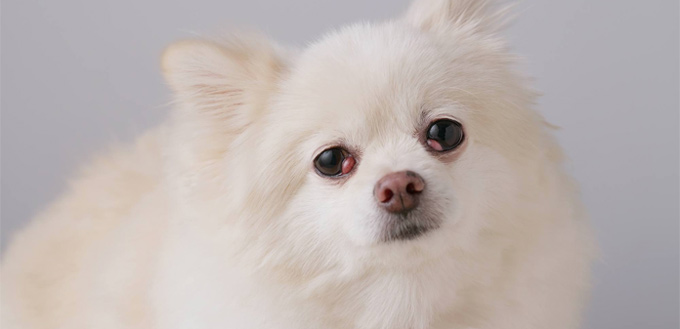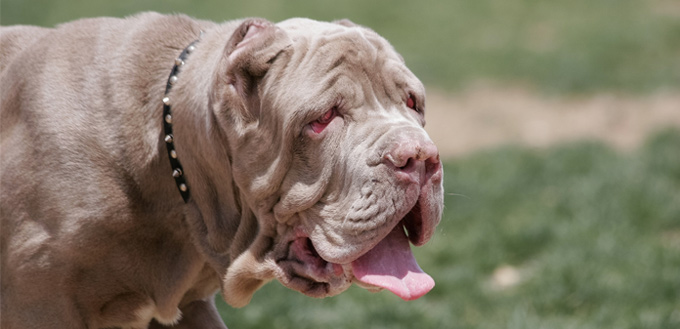How would you react when, on waking up in the morning, you notice a cherry sticking out of your dog’s eye? To a responsible pet owner, it will obviously cause a bit of a shock followed by plenty of concern. If you happen to be totally unaware of this condition, the best course of action would to call up your vet or resort to the Internet to find out what it is all about. The first bit of information that would come your way would describe it as ‘cherry eye’ and you will also be told not to panic since it is not a life-threatening condition.
All the same, a red blob sticking out of your dog’s eye is definitely disconcerting and as a pet owner, you must make an effort to understand how it is caused and steps that can be taken to handle it.

So, What Exactly Is Cherry Eye?
Medically known as ‘nictitans gland prolapse’, it is a condition wherein the tear gland located in the third eyelid of the dog’s eye bulges out. It protrudes like a red blob out of the inner corner of the eye, next to the dog’s nose, and appears to be quite painful, although it isn’t which explains why your canine may not be complaining about it.
Closer examination of a dog’s eye would reveal that unlike a human eye, it comprises of three eyelids. Among these, the upper and lower lids are always visible while the third lid remains hidden from view and is meant to serve a dual purpose of shielding the eye against dirt particles and keeping it moist. This third eyelid is also home to the tear gland and when it pops out from the corner of the eye in form of a red blob, the condition is referred to as cherry eye.
While the condition itself may not be life-threatening, it does deserve a certain degree of attention because there have been cases when it has become infectious. If you observe your dog as constantly pawing at his eye or presence of discharge in the region, thick or watery, it is time to pay a visit to the vet. Another characteristic of cherry eye is that it never remains limited to one eye – sooner or later the other eye is also bound to pop a cherry.
What Causes Cherry Eye In Canines?
Despite extensive research, the exact cause of cherry eye is yet to be identified and it still remains as one of the unsolved mysteries of the canine world. That being said, a number of deductions have been made as regards why it happens and reasons range from being physiological to genetic in nature.
A fact pertaining to cherry eye that is universally accepted is that it occurs when the connective tissue attaching the tear gland to the eye weakens. When this happens, the tear gland loses its anchor and is displaced from its position, thus protruding over the white portion of the eye like a cherry. However, what weakens the connective tissue is something that is still eluding experts and it is at this point that conjecture comes in.
The occurrence of cherry eye has also been attributed to genetic factors wherein experts feel that certain dog breeds are more vulnerable to suffer from this condition than others. Most breeds that are flat-faced with wide mouths, like beagles, bulldogs, pugs, poodles, and so on, have been found to have weak eye tissues and hence are regarded as being more prone to cherry eye. But this distinction is not sacrosanct and the condition can manifest itself in any dog irrespective of its breed.
Common Cherry Eye Symptoms
Apart from the signature symptom of round and red tear gland bulging out, other common symptoms associated with cherry eye are:
- Squinting of the eye, particularly if the canine suffers from pain;
- Dryness of eyes owing to the tear gland having swollen up and bulging out;
- In some cases cherry eye could be accompanied by swelling in the surrounding areas, but this does not happen always;
- Discharge – watery or thick – from the affected eye and this is indicative of the tear gland having been infected due to exposure;
- Impairment of vision
Although initially, it is just the cherry marking your dog’s eye, things could aggravate within no time if ignored. Dryness of the eye could cause the dog to scratch or paw at it in an attempt to relieve the irritation and this could lead to more serious issues like bleeding and injuries. Rather than wait for the condition to aggravate, you must immediately take your canine to the vet and explore possible treatment options.
Treating Cherry Eye
By itself, cherry eye should not be a cause of concern for pet owners but what needs to be thought of is the series of secondary problems that it can create. The longer the cherry eye is left in its place, the higher are the chances of more serious complications to occur and this is the reason as to why treatment should be sought as early as possible.
Objectives that timely treatment would fulfill are:
- Returning the tear gland to its rightful place and reinstating the third eyelid in the process;
- Minimize chances of discharge forming from the affected eye;
- Protect the eye from suffering any injury;
- Prevent irritation and dryness in the eye, both of which cause discomfort to the dog;
- Enable the tear gland to resume its function of keeping the eye moist
Treatment options to relieve the dog of cherry eye have evolved over the years and vary from using mild topical products to invasive procedures like surgery. There was a time in the past when the only method of treatment entailed removal of the tear gland, thus subjecting the eye to perpetual dryness. This method was then discarded because in addition to striping the eye of moisture, it also rendered the organ susceptible to infection, particularly variants of conjunctivitis. As a result, the canine was required to be taken to the vet many more times in order to be treated for dry eye and infection.
Gradually, more treatment options emerged, which are discussed as follows:
- Topical products
These need to be applied to the surrounding area wherein their purpose is to cause the swelling and inflammation to subside. At the same time they are also meant to shield the eye against secondary infections that are likely in the event of the tear gland being exposed.
That being said, topical medications are just meant to provide temporary relief and do not cure cherry eye. They just serve the purpose of short-term pain relievers until a more concrete treatment plan can be put into place.
- Surgery
Rather than remove the tear gland and subject the dog to a lifetime of dryness, experts recommend surgical re-positioning wherein the glad is put back in its place through a minor procedure. There are several techniques that can be employed to achieve this result and the choice of method depends upon the ease of being carried out and convenience of the dog as also its owner.
Suturing is a popular technique wherein the tear gland is tucked on to the orbital rim and sutured in place so as not to get dislodged. Another technique is pocket surgery wherein a new pocket is created and the gland is put in it after which the mouth of the pocket is closed. Invasive though this option might be, it can restore the eye to its original form if done properly, so much so that chances of recurrence are greatly minimized.
Something that the dog owner must bear in mind is the fact that opting for surgical procedure is by no means an assurance that cherry eye would not relapse in either of the eyes in future. Since there is no preventive measure, you would need to subject your canine to treatment every time it occurs.
Prognosis
As far as the surgical procedure is concerned, prognosis is very positive, given that post operation the eye is back to its normal state. While removal of the gland entails using eye drops for your dog for the rest of its life, repositioning ensures that the tear gland resumes its function of moisturizing the eye as it did before.
After the surgery, you must ensure that your dog takes proper rest to recover well, and all through the recuperation phase it would need to wear an Elizabethan collar to protect against scratching and rubbing.
Related Post: Dog Cones

Final Word
With the cherry eye having been cured, now is the time for you as the pet owner to start watching the other eye for the same problem to occur. At times pet owners do opt for surgery on both eyes at the same time as a preventive measure, but this is more of an exception than a rule.
Despite surgery, there is still a 20% chance of the gland slipping out once again and sticking like a cherry on your dog’s face. When that happens, it is all the way back to square one for you as also your beloved canine.
Make sure to also check out our review on the best dog tear stain removers.
Sources:
- Dr. Ernest Ward, Cherry Eye in Dogs, VCA
- Cherry Eye in Dogs, Wag!







